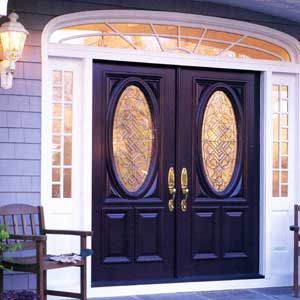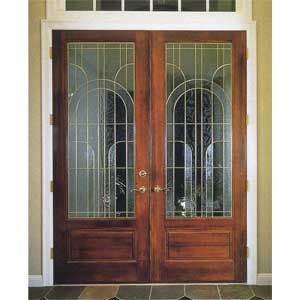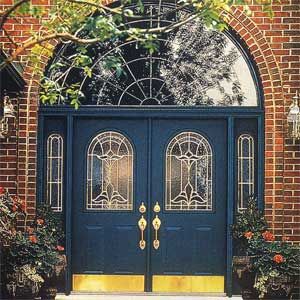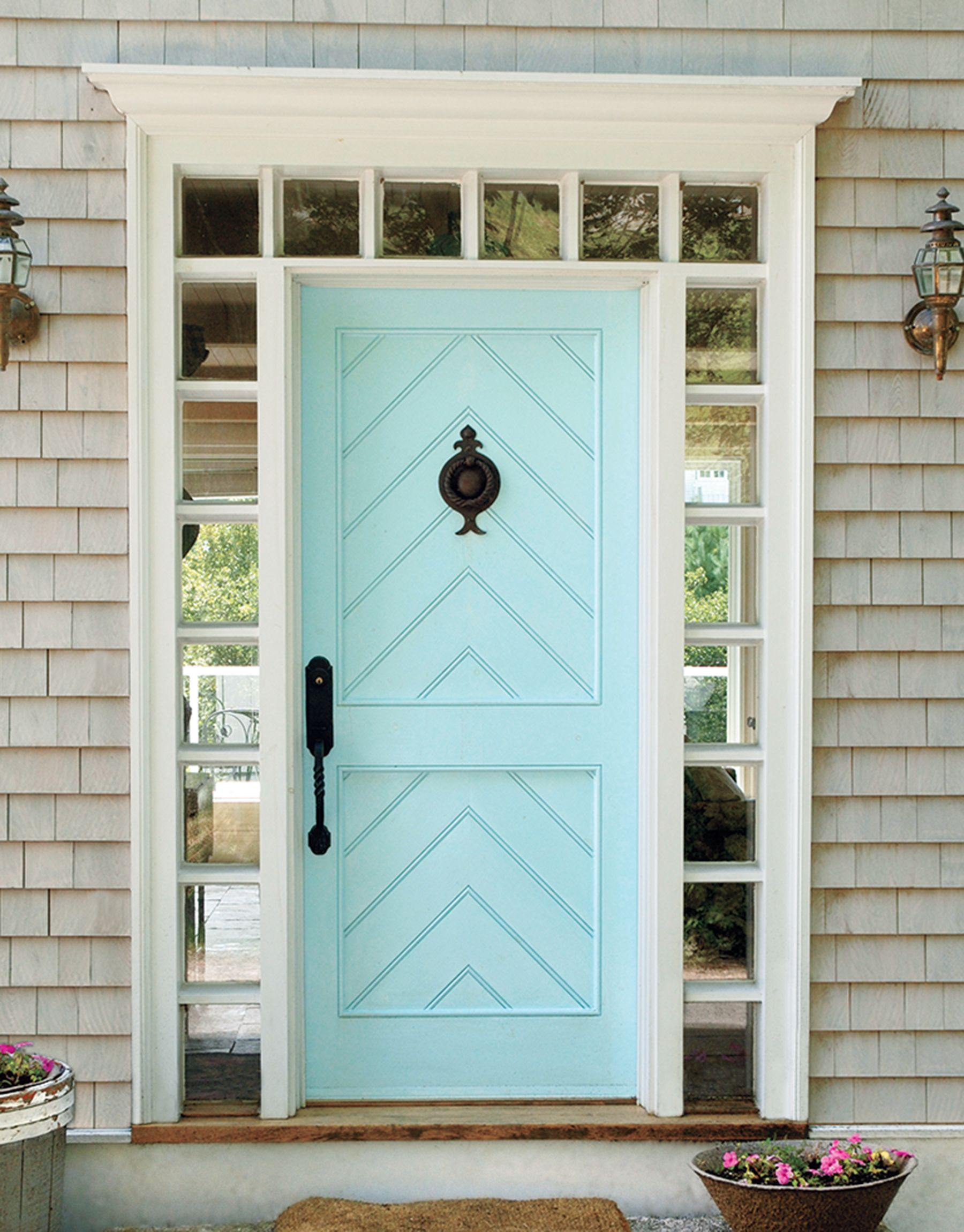Entry doors must be tough enough to withstand wind, rain, scorching sun, and would-be intruders, yet have enough curb appeal to make a good first impression. Unfortunately, meeting those needs is a tall order for many front doors.
In this guide, we’ll discuss the benefits and drawbacks of various door materials and tell you what you need to know about picking a new entry door system.
How To Replace a Front Door
Sometimes replacing a door means simply exchanging one door, called a slab or blank, for another. But in other cases you’ll have to rip out and replace the old door framing, which includes the door jambs and threshold—especially if the wood has begun to rot.
Even if the old door frame is fine, the wall studs it’s nailed to can bow and settle out of square. This makes it difficult to open and close the door. To make a new wood door fit an out-of-kilter frame, you’ll need to plane the top and bottom or even trim one of these edges so the door hangs correctly. However, this is only an option with a wood door, as metal and fiberglass doors can’t be planed or cut.
Prehung Front Doors
Most new doors are prehung, which means the door hangs on hinges within a new frame. These systems also include some form of weatherstripping. Prehung doors are an ideal choice if the old frame is bad or if you’re removing the frame because you want to enlarge the opening. They are quicker to install because all the proper hardware is already assembled and attached.
Replacing a prehung front door can be a DIY job as long as you have at least one other person to help you lift the door into place. If you’re replacing your old door with a prehung unit, first determine whether you need a left- or right-hand door. Stand in the doorway and face outside. If the lockset is on your right, you have a right-hand door. You’ll also need to determine whether you want an inswing or outswing door. Both come in left- and right-handed models.
To choose the proper jamb size, measure the height and width of the existing door jamb between the inside edges of the casing. Add 1/2 inch to the frame height and 1/2 inch to 3/4 inch to the width. The width of the door is measured across its face. Standard single doors are 36 inches wide by 80 inches high, but width can vary from 30–36 inches and height from 80–96 inches.
Door Replacement Kits
An alternative to replacing the entire frame is to use a door replacement kit. Here, the door is prehung in a small steel frame that attaches to the old one. Benefits include easy installation and the added security of the steel frame. However, these kits slightly reduce the size of the original opening, they’re available in only a few sizes, and they can’t be installed over rotted jambs.
Front Door Designs
Most manufacturers offer dozens of door styles, and you’ll find a broad selection at lumberyards, home centers, and door dealers. Or you can design your own door. Some manufacturers let you specify the types of panels and glass options you want. But these doors have to be specially ordered and can take weeks for delivery. A third option is to have a local woodworker or millwork shop create a wood door according to your specifications. Again, the drawbacks are time and money.

Best Materials For Front Doors
Perhaps the most important decision is what your door is made of. Most combine several materials—for example, many fiberglass and steel doors have wood frames. But it’s the surface material that most affects appearance, durability, security, and price.
Most older ones are made of wood or wood veneer, both of which warp, crack, and delaminate after years of exposure to the elements. Metal doors don’t last forever, either, as the surface on some older steel doors can peel.
However, there are new wood doors that resist the elements better than earlier versions, as well as metal and fiberglass ones that look like wood but provide greater security and often cost less. Whether your front door is rotting or you just want to update the look of your home’s entryway, you’ll find plenty of options available.
Wood Doors
Wood doors are the most common. Versatility and beauty are their strong suit. Natural-finish stock and custom wood doors come in oak, cherry, walnut, mahogany, maple, fir, and pine. You’ll also find paint-grade doors in several softwood varieties, such as pine and Western hemlock.
Many stock wood doors, which are often the best fit for small budgets, are not made of pure hardwood. Instead, they consist of a sandwich of wood-veneer skins over an engineered-wood core. This configuration minimizes the expansion and contraction that cause warping. At about $150* to start, they’re a low-cost alternative to solid-wood doors. Look for tough, furniture-grade veneers at least 1/16 inch thick—anything thinner damages too easily.
Companies such as Taylor, Pella, and Simpson manufacture exterior doors that discourage bowing and warping by laminating two pieces of wood to create the stiles and rails. Split construction is also used for the door panels, but they have an insulated core for increased energy efficiency. The result is a wood door with an insulation value of about R-5 compared with R-2 for conventional versions, though you’ll pay more for these doors than stock models.
Solid-wood doors cost the most. You could pay up to $5,000 for a complete system that includes a prehung hardwood door in its frame, hinges, locksets, sidelights, and weatherstripping. In addition to the high cost, another drawback of wood doors is maintenance. You may need to remove, sand, and refinish it every few years, especially if you live in a high-humidity climate. However, a high-quality finish can reduce this maintenance.
When shopping for prefinished wood doors, look for durable stains and clear finishes, such as polyurethane. If you intend to finish the door yourself, high-gloss sheens offer the best protection for painted doors. Whichever finish you choose, apply it to the top and bottom edges. This helps prevent a wood door from absorbing moisture and swelling.
Look for careful detailing as signs of product quality. As a rule, the more intricate the carvings and moldings, and the thicker and wider the stiles and rails, the better the door. The same goes for panel thickness. For example, the high-end doors from Nord have 1 3/8-inch panels compared with the 9/16- and 3/4-inch panels on low-end models.

Steel Doors
A steel door is your best bet if security and durability are top priorities. Steel units are stronger than wood or fiberglass doors, and because they don’t expand and contract with changing weather, they won’t crack or warp. Any dents or dings on these doors can be pulled and puttied with an auto-body repair kit.
Steel doors are also comparable in cost to stock wood doors. Prices start at about $150 for a 3-foot-wide by 6-foot, 8-inch-tall paneled door without hardware or glazing. A steel-door system with sidelights and premium hardware can nearly equal the cost of a solid wood-door system, however. Additionally, while steel doesn’t rot, it can rust if not properly maintained.
All steel doors have an inner frame made of wood or, for greater strength, steel. The cavities within the frame are filled with high-density foam insulation. Premium doors typically have a 24-gauge skin and a steel frame, though some offer heavier-gauge steel (represented by a lower number). The surface is usually smooth or has an embossed wood-grain pattern.
Most steel doors are coated with a baked-on polyester finish that requires periodic repainting. Premium versions get a vinyl coating similar to the one on vinyl-clad windows for greater weather resistance. Some even have a stainable wood-fiber coating or, on really high-end versions, a laminated-wood veneer.
Steel doors usually are part of a prehung system. But if you’re simply lifting the old door off its hinges and hanging a new one, remember that steel doors come with hinges attached or predrilled holes for the hinges. The hinge area on the door must match the hinge area on the existing door frame. Some doors come with an extra predrilled hole for the hinges, which allows for minor adjustments when hanging the door.

Fiberglass-Composite Doors
Fiberglass-composite doors are tough and maintenance-free, and are a smart choice for harsh or humid climates. They mimic the look of wood with wood-grain texturing and can be stained to match oak, cherry, walnut, and a variety of other woods. Beneath their molded surface is a framework of wooden stiles and rails, including wood edges for the lockset. Voids in the framework are filled with polyurethane-foam insulation.
Fiberglass-composite doors often carry long warranties. But because installation affects longevity, these lengthy warranties usually come only on complete entry systems that include the frame. If you only want a slab door, the warranty may not apply.
Affordability is another plus. Expect to pay about $200 for a 3-foot-wide by 6-foot, 8-inch-tall paneled composite door without glazing or hardware. But because accessories cost the same regardless of the material, a fully loaded fiberglass entry system can cost about $4,000.
If you choose a fiberglass composite door with an embossed wood-grain, make sure the pattern runs horizontally on the rails and vertically on the stiles, like real wood grain. And if you’re installing just the door, be sure the hinges line up with the existing frame.
Aluminum Doors
Aluminum doors, like steel units, use an insulation core covered by a metal skin.
Manufacturers offer all types of options, in dozens of styles and colors, with smooth or wood-grain finishes. Keep in mind, however, that aluminum is a conductive material, and though aluminum doors are typically insulated, they tend to be less energy efficient.
Aluminum doors have a baked-on enamel finish, so they never need painting and won’t rust—which explains the 20-year warranties that are common. You can also match the color and style of your door with an aluminum storm door. All these benefits don’t come cheap, however. At prices that start at about $300 and range into the thousands, aluminum doors are the most expensive choice after solid wood.
*Costs in this section sourced from HomeAdvisor.
How To Buy a Front Entry Door
Whether you buy the door by itself or the entire door-and-frame system, keep these shopping tips in mind:
- For complete entry systems, be sure all components come from the same manufacturer. Some systems may be assembled by distributors with parts that might not mate perfectly. Check that the weatherstripping seals properly and that the threshold interlocks with the bottom edge of the door.
- Look for low-e glazing, which will further increase energy efficiency, on units with windows. For added security, some manufacturers offer glazing designed to resist break-ins. Decorative windows with real lead or brass caming (metal between glass panes) cost more than ones with plastic or other material options.
- High-quality steel and fiberglass doors have a thermal break—often a vinyl strip or part of the wood frame—that separates the inside and outside door skins. This prevents outside cold and heat from transferring through the skin and frame and frost from forming on the inside surface.
Our Conclusion
Weigh your budget against durability when choosing the design and material of your new exterior door. Picking the right front door will pay off in smoother operation, less maintenance, and added energy savings. You’ll also have an elegant entry that makes a great first impression for years to come.

